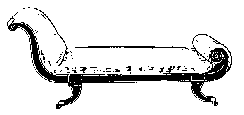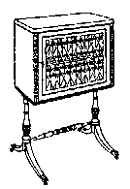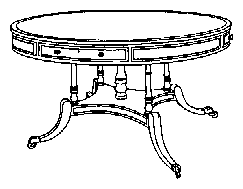Regency Furniture – English Period
Regency Furniture
(Mahogany, Rosewood and Ebony 1800-1830)
Regency followed a style in France after the coronation of Napoleon as Emperor (Empire Style).
Prince George became Regent from 1811-1820 – this was a period of classical furniture. It was then the fashion to copy actual furniture of the classical Roman and Greek times. If they were not identically copied, they were made as close as possible to the classical decoration forms. Winged Griffins, lions heads, animal legs, Roman Gods: anything that was popular in ancient Rome, Egypt or Greece. Furniture had moved from natural evolution to return to Classical form. The settee returned to a couch with scrolled ends supported by sphinx heads on lions legs.

Regency Furniture – Grecian Couch c 1805
Designers who distinguished themselves in this period were Thomas Hope, George Smith, and Henry Holland. George IV had a large influence over the craftsmen of the time. The pinnacled, mosque like Pavilion at Brighton, England reflects some of the final madness of this period.

Regency Bookcase on a stand c 1810, the front has a metal grill.
Features of Regency Furniture
- The addition of brass to wood. Brass inlays were longer lasting than marquetry and this lead to the revival of French Boulle decorations.
- Sofa Table
- Sabre Leg
- Cable Twist
- Metal Grille
- Commode was replaced by the chiffionier – straight front low cupboard
- Cheaper pieces sometimes painted with black lacquer -revival of japanning
- The current fashion was for decorating walls with paintings which led to lower pieces.
- Tallboys disappeared and bookcases and cabinets became smaller.
- Wide use of metal mounts, lion paw feet, fretted brass grilles cover glass doors, pierced galleries, supports for shelves.
- Ormolu – imitation gold.

Regency Library Table c 1825
- Chest with front pilasters of classic forms, sphinx head on animal legs or caryatid – female figure.
- Scrolled end couches. Wooden frame often gilded.
- Circular tables, some with marble tops, stood on plinth base with animal feet.
- Sabre shape legs decorated with reeding or brass inlay.
- Brass boss used at junction of leg and rail.
- Trafalgar chair used in mourning, death of Nelson. Cable twist,
- sabre legs.
- Novelties – Canterbury to carry music or plates
- Whatnot to display small pieces.
- Davenport small writing desk.
- Twin quadrople tables.
- Sofa Tables – long narrow table with a drop leaf at each end and two drawers.
- Sideboard in the Adam style with solid pedestals and urns grew quite massive.
- Lyre shape used for table ends.
- Quadruple support.
More information on Styles and Periods of Interior Decorating
Styles and Periods
Furniture History
Decorating Styles
Period Decoration
What is Style?
